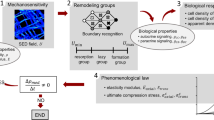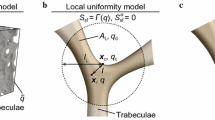Abstract
Cancellous bone has a complicated three-dimensional porous microstructure that consists of strut-like or plate-like trabeculae. The arrangement of the trabeculae is remodeled throughout the organism’s lifetime to functionally adapt to the surrounding mechanical environment. During bone remodeling, osteocytes buried in the bone matrix are believed to play a pivotal role as mechanosensory cells and help regulate the coupling of osteoclastic bone resorption and osteoblastic bone formation according to the mechanical stimuli. Previously, we constructed a mathematical model of trabecular bone remodeling incorporating cellular mechanosensing and intercellular signal transmission, in which osteocytes are assumed to sense the flow of interstitial fluid as a mechanical stimulus that regulates bone remodeling. Our remodeling simulation could describe the reorientation of a single strut-like trabecula under uniaxial loading. In the present study, to investigate the effects of a bending load on trabecular bone remodeling, we simulated the morphological change in a single trabecula under a cyclic bending load based on our mathematical model. The simulation results showed that the application of the bending load influences not only the formation of the plate-like trabecula but also the changes in trabecular topology. These results suggest the possibility that the characteristic trabecular morphology, such as the strut-like or plate-like form, is determined depending on the local mechanical environment.
Similar content being viewed by others
References
Adachi T., Aonuma Y., Taira K., Hojo M., Kamioka H.: Asymmetric intercellular communication between bone cells: propagation of the calcium signaling. Biochem. Biophys. Res. Commun. 389, 495–500 (2009)
Adachi T., Kameo Y., Hojo M.: Trabecular bone remodeling simulation considering osteocytic response to fluid-induced shear stress. Phil. Trans. R. Soc. A 368, 2669–2682 (2010)
Adachi T., Tsubota K., Tomita Y., Hollister S.J.: Trabecular surface remodeling simulation for cancellous bone using microstructural voxel finite element models. J. Biomech. Eng. 123, 403–409 (2001)
Beno T., Yoon Y.J., Cowin S.C., Fritton S.P.: Estimation of bone permeability using accurate microstructural measurements. J. Biomech. 39, 2378–2387 (2006)
Bonewald L.F., Johnson M.L.: Osteocytes, mechanosensing and Wnt signaling. Bone 42, 606–615 (2008)
Burger E.H., Klein-Nulend J.: Mechanotransduction in bone—role of the lacuno-canalicular network. FASEB J. 13, S101–S112 (1999)
Cowin S.C.: Bone poroelasticity. J. Biomech. 32, 217–238 (1999)
Cowin S.C., Moss-Salentijn L., Moss M.L.: Candidates for the mechanosensory system in bone. J. Biomech. Eng. 113, 191–197 (1991)
Frost H.M.: Bone “mass” and the “mechanostat”: a proposal. Anat. Rec. 219, 1–9 (1987)
Frost H.M.: Bone’s mechanostat: a 2003 update. Anat. Rec. A Discov. Mol. Cell Evol. Biol. 275, 1081–1101 (2003)
Han Y., Cowin S.C., Schaffler M.B., Weinbaum S.: Mechanotransduction and strain amplification in osteocyte cell processes and flow across the endothelial glycocalyx. Proc. Natl. Acad. Sci. USA 101, 16689–16694 (2004)
Huiskes R., Ruimerman R., Van Lenthe G.H., Janssen J.D.: Effects of mechanical forces on maintenance and adaptation of form in trabecular bone. Nature 405, 704–706 (2000)
Huo B., Lu X.L., Hung C.T., Costa K.D., Xu Q., Whitesides G.M., Guo X.E.: Fluid flow induced calcium response in bone cell network. Cell. Mol. Bioeng. 1, 58–66 (2008)
Jaworski Z.F., Lok E.: The rate of osteoclastic bone erosion in haversian remodeling sites of adult dogs rib. Calcif. Tissue Res. 10, 103–112 (1972)
Kameo Y., Adachi T., Hojo M.: Transient response of fluid pressure in a poroelastic material under uniaxial cyclic loading. J. Mech. Phys. Solids 56, 1794–1805 (2008)
Kameo Y., Adachi T., Hojo M.: Fluid pressure response in poroelastic materials subjected to cyclic loading. J. Mech. Phys. Solids 57, 1815–1827 (2009)
Kameo Y., Adachi T., Hojo M.: Estimation of bone permeability considering the morphology of lacuno-canalicular porosity. J. Mech. Behav. Biomed. Mater. 3, 240–248 (2010)
Kameo Y., Adachi T., Hojo M.: Effects of loading frequency on the functional adaptation of trabeculae predicted by bone remodeling simulation. J. Mech. Behav. Biomed. Mater. 4, 900–908 (2011)
Kamioka H., Kameo Y., Imai Y., Bakker A.D., Bacabac R.G., Yamada N., Takaoka A., Yamashiro T., Adachi T., Klein-Nulend J.: Microscale fluid flow analysis in human osteocyte canaliculus using a realistic high-resolution image-based three-dimensional model. Integr. Biol. 4, 1198–1206 (2012)
Kamioka H., Honjo T., Takano-Yamamoto T.: A three-dimensional distribution of osteocyte processes revealed by the combination of confocal laser scanning microscopy and differential interface contrast microscopy. Bone 28, 145–149 (2001)
Knothe Tate M.L., Knothe U., Niederer P.: Experimental elucidation of mechanical load-induced fluid flow and its potential role in bone metabolism and functional adaptation. Am. J. Med. Sci. 316, 189–195 (1998)
Majumdar S., Kothari M., Augat P., Newitt D.C., Link T.M., Lin J.C., Lang T., Lu Y., Genant H.K.: High-resolution magnetic resonance imaging: three-dimensional trabecular bone architecture and biomechanical properties. Bone 22, 445–454 (1998)
McNamara L.M., Prendergast P.J.: Bone remodelling algorithms incorporating both strain and microdamage stimuli. J. Biomech. 40, 1381–1391 (2007)
Müller R., Hildebrand T., Rüegsegger P.: Non-invasive bone biopsy: a new method to analyse and display the three-dimensional structure of trabecular bone. Phys. Med. Biol. 39, 145–164 (1994)
Osher S., Sethian J.A.: Fronts propagating with curvature-dependent speed: algorithms based on Hamilton-Jacobi formulation. J. Comput. Phys. 79, 12–49 (1988)
Parfitt A.M.: Osteonal and hemi-osteonal remodeling: the spatial and temporal framework for signal traffic in adult human bone. J. Cell. Biochem. 55, 273–286 (1994)
Smit T.H., Huyghe J.M., Cowin S.C.: Estimation of the poroelastic parameters of cortical bone. J. Biomech. 35, 829–835 (2002)
Sugawara Y., Kamioka H., Honjo T., Tezuka K., Takano-Yamamoto T.: Three-dimensional reconstruction of chick calvarial osteocytes and their cell processes using confocal microscopy. Bone 36, 877–883 (2005)
Tatsumi S., Ishii K., Amizuka N., Li M.Q., Kobayashi T., Kohno K., Ito M., Takeshita S., Ikeda K.: Targeted ablation of osteocytes induces osteoporosis with defective mechanotransduction. Cell Metab. 5, 464–475 (2007)
Tsubota K., Adachi T.: Spatial and temporal regulation of cancellous bone structure: characterization of a rate equation of trabecular surface remodeling. Med. Eng. Phys. 27, 305–311 (2005)
Tsubota K., Suzuki Y., Yamada T., Hojo M., Makinouchi A., Adachi T.: Computer simulation of trabecular remodeling in human proximal femur using large-scale voxel FE models: approach to understanding Wolff’s law. J. Biomech. 42, 1088–1094 (2009)
Wang Y., McNamara L.M., Schaffler M.B., Weinbaum S.: A model for the role of integrins in flow induced mechanotransduction in osteocytes. Proc. Natl. Acad. Sci. USA 104, 15941–15946 (2007)
Weinbaum S., Cowin S.C., Zeng Y.: A model for the excitation of osteocytes by mechanical loading-induced bone fluid shear stresses. J. Biomech. 27, 339–360 (1994)
You L.D., Cowin S.C., Schaffler M.B., Weinbaum S.: A model for strain amplification in the actin cytoskeleton of osteocytes due to fluid drag on pericellular matrix. J. Biomech. 34, 1375–1386 (2001)
You L.D., Weinbaum S., Cowin S.C., Schaffler M.B.: Ultrastructure of the osteocyte process and its pericellular matrix. Anat. Rec. A 278, 505–513 (2004)
Author information
Authors and Affiliations
Corresponding author
Rights and permissions
About this article
Cite this article
Kameo, Y., Adachi, T. Modeling trabecular bone adaptation to local bending load regulated by mechanosensing osteocytes. Acta Mech 225, 2833–2840 (2014). https://doi.org/10.1007/s00707-014-1202-5
Received:
Revised:
Published:
Issue Date:
DOI: https://doi.org/10.1007/s00707-014-1202-5




